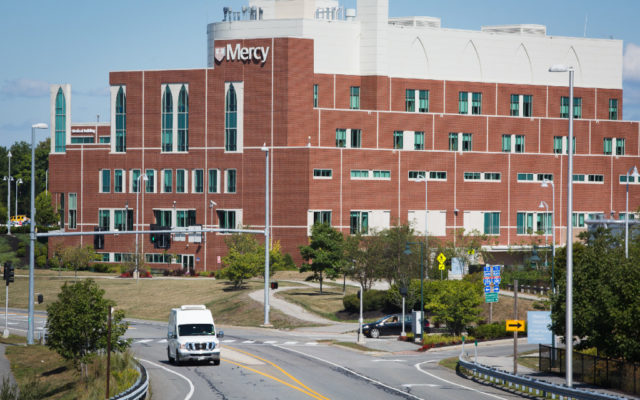
COVID-19 hospitalizations rising more slowly than during Maine’s 1st virus surge
By Charles Eichacker, Bangor Daily News Staff
The number of Mainers being admitted to the hospital with COVID-19 is ticking up more slowly now than it did during the initial surge of the coronavirus last spring, even though new cases of the virus in the state are reaching record levels.
That’s partly because the state’s new cases are trending younger, with fewer outbreaks in nursing homes and more of them among people in their teens, 20s, 30s and 40s who are not as vulnerable to the worst health effects of the virus.
It’s also because hospitals have learned a great deal more about how to treat the virus since last spring, with medications that help patients leave the hospital sooner and other advances that allow more people to recover from home.
The seven-day rolling average of new daily COVID-19 hospitalizations in Maine has more than doubled in the last two weeks, from 0.9 on Oct. 18 to 2.3 on Sunday, according to state data.
But so far, that’s a more modest upswing than the state saw after its first coronavirus case was found on March 12, when the seven-day average of new hospitalizations grew by more than five times in the subsequent two weeks. It eventually peaked at six new hospitalizations per day in early April and again in late May — in both cases after nursing homes had suffered bad outbreaks.
There are now 29 people hospitalized with COVID-19 in Maine, compared to around 60 at the height of those earlier spikes.
So far, there has not been a noticeable uptick in COVID-19 deaths across the state as cases have spiked, with the rolling average of new daily deaths not climbing above one since early June. But that could start to change as more people become sick enough that they need to go to a hospital, according to Nirav Shah, director of the Maine Center for Disease Control and Prevention.
“We are deeply concerned about that,” Shah said on Monday. “Of course, we hope that the number of individuals who pass away with COVID-19 does not return to what we saw on a day-by-day basis back in March and April. That is, unfortunately, a possibility.”
Maine has recorded one of the lowest death rates in the country, behind just two other states — Vermont and Alaska — during the pandemic, according to The New York Times.
While many of Maine’s early COVID-19 cases — and, as a result, hospitalizations — were concentrated in southern Maine, the spread of new hospitalizations now appears to be wider.
For example, from early September to late October, MaineGeneral Medical Center in Augusta never had more than one COVID-19 inpatient at a time, according to spokesperson Joy McKenna. But admissions started to increase a week-and-a-half ago, and the facility now has nine inpatients with COVID-19, including one who needs intensive care.
Northern Light Eastern Maine Medical Center in Bangor now has four admitted COVID-19 patients after going roughly a month without any, and its smaller affiliate hospitals in Waterville and Pittsfield have one and two inpatients, respectively, according to Dr. James Jarvis, clinical lead for the coronavirus incident command at their parent organization. Until recently, there was also at least one admitted patient at Northern Light A.R. Gould in far northern Presque Isle.
Jarvis noted that many of Northern Light’s earlier admissions were at Northern Light Mercy Hospital in Portland, which has been the hardest-hit section of Maine throughout the pandemic.
The more rural spread of hospitalizations is at least partly related to the types of cases the system is now seeing: people who may need breathing assistance but are not sick enough to require a ventilator or other advanced care.
“It’s not common for us to have any at our smaller hospitals, but I think that speaks more to patients not needing intensive care and not needing to be transferred to bigger facilities,” Jarvis said.
Northern Light Health providers have managed to move people out of the hospital more quickly by administering antiviral treatments such as remedesivir, which has meant fewer people occupying beds at the same time. With the right protective gear, home care providers can also now safely see patients in their homes.
While it’s unclear how many Mainers could become infected over the coming weeks and months, Northern Light hospitals have learned enough about how to contain the spread of COVID-19 and have stocked up on enough protective gear that they are not currently planning to cancel or delay any other nonessential services, as they had to do last spring, according to Jarvis.
Even if hospitals have become more adept at treating COVID-19, health experts are renewing their calls for strict adherence to measures that can prevent the disease from spreading to more vulnerable individuals, including wearing face masks, socially distancing and avoiding gatherings — particularly those in poorly ventilated, indoor spaces. They are also urging people to get the flu shot, to limit how many people must seek treatment for coronavirus-like symptoms this winter.
While deadly nursing home outbreaks have become less common in Maine, they become more likely when COVID-19 is circulating throughout the surrounding community, as is now happening in communities all across the state, according to Shah.